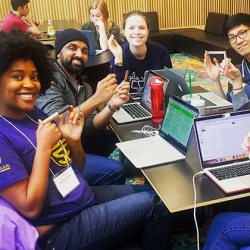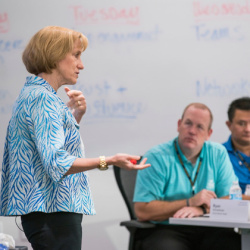Q-and-A: How Smart Managers Can Effectively Lead Newly Remote Teams During COVID-19 Pandemic

As countless companies of all sizes find themselves shifting to remote work due to the novel coronavirus pandemic, the challenge also creates opportunities. Michigan Ross Professor Lindy Greer, faculty director of the Sanger Leadership Center, says that now is a great time for organizations to change their thinking in ways that will improve the people side of their operations long after the current crisis has passed.
With many more people working from home, what will be the effects on the HR or “people” aspects of business?

Greer: When shifting to remote work, companies will likely experience substantial people challenges in terms of communication, conflict management, and motivation. Remote work is like a magnifying glass for underlying people issues in companies — people problems that can be glossed over or shoved under the rug in face-to-face teams tend to explode, and quickly, when companies go remote.
This is because remote work, when not carefully done, lacks the social context of face-to-face work. The small social cues that can help smooth social interactions go away, and this means underlying conflicts become more manifest, coordination issues become roadblocks more quickly, and so on.
The silver lining of this is that these difficulties in going remote run will force companies to take a more intentional approach to people dynamics than they did when operating in person, and this intentionality around people issues will only make companies that much more effective when in-person operations resume again.
Indeed, when you talk to the CEOs of companies on the top 10 remote companies list (such as 10up or Automattic, the company behind WordPress), they strongly believe remote work has made them better at the people issues in their organizations than companies run in person because it has forced them to be so intentional on the people side of business. This includes providing infrastructure to coordinate workers, virtual coffee rooms to promote social bonding, employee recognition programs for motivation, virtual town halls to reduce power distance, and clear norms and etiquette around meetings and internal communications.
How should smart companies react to the new reality?
Greer: They should be quick to realize the challenge of remote work and build in solutions to “scaffold” the people-side of work. Again, this intentionality will serve them well not only during remote work periods like this, but also back in the office in person.
As examples of this, our team in the Sanger Leadership Center has a subcommittee working on re-clarifying our cultural values and practices, including thinking about how to bring them into the virtual environment. How can we preserve our culture in this new way of working, as well as get super intentional and clear about what our culture is more generally? We also are working on writing down our rules for running meetings online, such as ensuring speaking time for each person and keeping discussions to fewer than five people.
These are all good people practices, and backed by lots of research in management and psychology. Remote work is forcing us to get better at them now.
What are some differences between remote teams and face-to-face teams?
Greer: The primary differences between remote and face-to-face teams lie in less media richness (fewer social cues available over email or call than face-to-face), increased media asynchronicity (fewer real-time conversations, unless you plan for this using Slack or Google Hangouts), and geographic dispersion with implications around time zones and cultural differences.
What are some similarities?
Greer: The research would suggest that people are people, and the challenges are the same between face-to-face and remote teams. It's only that these challenges blow up more quickly online, due to the nature of less rich communication media. Getting good at remote work will make companies better at face-to-face work.
How can team members remain effective in remote situations when they’re used to working face-to-face? What other suggestions do you have for effectively working from home?
Greer: Broadly stated, get super intentional about the people side of work. For employees, this means being aware of your own motivation and energy and finding ways to structure your work-home life to support yourself right now. Sue Ashford wrote a great blog on this for Ross recently, which I personally found very helpful.
Additionally, research suggests having a routine, knowing your needs (social contact, physical movement, structure), and building (and holding to) a daily routine that is intentionally designed to meet those needs is critical.
For leaders running effective remote teams, it's important to take the time now to make a plan about how to be intentional about the people side of your teams. When being intentional about teams, I always start first with Situational Awareness, and then look at four key criteria that every team (and leader!) needs — specifically, can my team COPE? This includes assessing Culture (value-based, meaningful, and inclusive rituals, artifacts, and norms), Objectives (clear, fair, and motivating performance targets), Processes and norms (playbooks for how to communicate and work together), and Experimentation (support for flexibility and adaptation). For more on this framework and its origins at Ross (created by Bob Quinn and Kim Cameron and elaborated on in the Michigan Model of Leadership by Dean D. Scott DeRue, Sue Ashford, Gretchen Spreitzer, and colleagues), see: https://sanger.umich.edu/our-model/.
Specific actions you can take to address each of these critical team needs right now includes:
Situational Awareness: Know how your team is feeling and what they need, and work to meet team needs.
Take the time to do one-on-ones with direct reports to understand their needs right now. What are their emotions and their energy? What do they need to be productive? What resources do they need? Interestingly, successful remote companies agree that having a large budget to set up a comfortable home office is critical. Has your organization updated policies and secured funding to help support employees to comfortably work at home?
Relatedly, set up an energy/culture check within your teams. Have a meeting at the end of the week to see how the team is doing; you might need to adapt for next week. Or send out an anonymous culture pulse survey at the end of every week to do an energy check. Gratitude checks or asking for positives of the week can also be helpful practices in helping people reappraise the situation.
Culture: Form a culture subcommittee and find ways to really emphasize your mission and values right now.
Empower this committee to find and set into action three to five cultural practices that can bring your company's values and missions alive in a remote work environment. How can cultural traditions have continuity in the new way of work? How can traditional offsites be run online? How can rituals celebrating successes be brought into the online environment?
In addition to ensuring that your culture translates to remote work, reminding people of your core mission and values is also a great way to provide stability and motivation during turbulent times (and ensure alignment and motivation during times of smooth sailing as well).
Objectives: Ensure that individual and team performance goals and responsibilities are clear (and visible in a daily way).
Setting long-term company goals and then being clear how that translates to team and individual objectives each week (and is visible in daily life for employees, including in new online environments) is always important. If you are not already using project management software such as Asana, now is the time. Minimally, even a shared Google sheet that clarifies who owns what and when it's expected to be done can be helpful, especially if it’s something engaging that people will want to log in to and look at every morning. Providing people with goals and ensuring mechanisms for accountability will keep your remote team going and make the team even better when it goes back to face-to-face.
Don't forget to build in a little extra time in the next few weeks, though, as people adjust to the new normal — again, show compassion, know individual needs and bandwidths right now, and adjust goals accordingly. But do set, communicate, and make visual realistic goals as a way of increasing energy and preserving team alignment and direction.
Processes and Norms: Make a playbook for communication and meeting norms in the remote-work environment.
Where are quick-response questions communicated that used to be done face-to-face? (Over Google chat, Asana, Slack?) What is the structure for an ideal meeting? What types of meetings are there? How are the rules to run decision-making meetings different from town halls or larger standup meetings? (Three to five people in the virtual room is ideal for decision-making/problem-solving meetings. For larger town halls or standups, you can have more people, but people should be on mute unless speaking and chat functions should be used to gather questions and ideas.) What are the norms about video on/off? (Research suggests video always on, unless there are extreme circumstances, is the best!)
Experimentation: Make sure your team is actively experimenting, adapting, and being flexible by being mindful of your own mindset, self-compassion, and flexibility as a leader, and then finding ways to support your team on these topics as well.
Coping with change requires flexibility. To be flexible and adaptive, you have to start with both compassion and a growth mindset for yourself as leader. For example, Sue Ashford and colleagues found that leaders can only help others if they have compassion for themselves. So make sure you are taking care of you, getting your head in the right space, and setting the right image for your team.
Then make sure you are doing everything you can do to show compassion for the different needs in your team. Use this compassion for yourself and your team to help promote a growth orientation for members to learn how to flexibly adapt to a new way of work.
Lindy Greer hosted an online seminar titled “Why Remote Work Makes Teams and Leaders Better.” Watch it here. Greer is an associate professor of management and organizations, Michael R. and Mary K. Hallman Fellow, and the faculty director of the Sanger Leadership Center at the University of Michigan Ross School of Business.
MORE RESOURCES FROM THE SANGER LEADERSHIP CENTER
WATCH THE WEBINAR ON REMOTE WORK
Media Contact: Bridget Vis, Public Relations Specialist, visb@umich.edu







